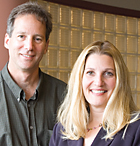
Traditional nursing home care has focused on a medical model of care delivery. Charles T. Sitrin Health Care Center is looking forward to a culture change that will soon be happening in central New York to improve the service delivery of care for a growing elderly population by providing high quality, affordable and sustainable long-term care services in home-based settings. By changing the caregiver’s emphasis from the task being performed to the relationship with the resident, a cultural evolution takes place. At Sitrin, we are applying new technologies, new architecture and enhancing our workforce processes to enact just such a culture change to enrich the lives of long-term care recipients and the people who care for them.
Since 2003, Sitrin has been involved with the Center for Health Care Design, a leading research and advocacy organization comprised of forward-thinking healthcare and design professionals. This organization is leading the quest to maximize the quality of healthcare delivery through an intense focus on design, architecture, and the built environment. The mission of the Center for Health Care Design is to transform healthcare settings into healing environments and to improve clinical outcomes through evidence-based designs. There are a number of hospitals involved with the Center for Health Care Design and a smaller number of long term care facilities. Sitrin is one of the first long term care facilities to become a member or “Pebble Partner” with the Center for Health Care Design.
Sitrin is located in Central New York. This residential healthcare facility will be undergoing a tremendous transformation in the way healthcare services are delivered to patients and residents. In the winter of 2007, Sitrin started an expansion project with the construction of nine new residential style houses built to accommodate 110 long term care residents. Residents will moved in the spring of 2009 from the current double-barrel hallways with a traditional hierarchical healthcare delivery model to newly built residential style cottages. These homes will have private bedrooms & baths, kitchens, and living rooms.
Sitrin’s decision to expand took place after a rightsizing proposal was approved by the Department of Health in June 2006. This approval has allowed Sitrin to decertify 17 Residential Health Care Facility (RHCF) beds and convert them to Assisted Living Program (ALP) beds. These ALP beds will be built as part of Cedarbrook. When completed, Cedarbrook will consist of 17 ALP beds as well as 47 additional beds to be certified under New York’s recently approved Assisted Living Residence regulations.
Sitrin will be capitalizing on the tremendous opportunity afforded by this change in the physical environment as a natural setting to conduct a research program designed to ensure that major stakeholders in the Sitrin Community are well-served by the transformation. Sitrin will then use the research outcomes to contribute to published scholarship in long-term care practices. The hope is that the change in healthcare delivery will have a very positive outcome on the residents and their family members, the workplace experiences of the staff, and the medical delivery systems employed.
Several research topics based upon the transformation are currently under investigation at Sitrin. The foci of the research include clinical outcomes, patient safety and quality assurance, staff stress and job satisfaction, and family stress and attitudes. Some of the questions we would like to answer are: What social and clinical benefits are derived by the residents due to the transformation as Sitrin changes from a traditional long-term care facility to a residential community model in a cottage-based setting? What are the effects on medicine-dispensing errors and the pattern of use of psychotropic medications? What are the changes in staff attitudes and behaviors? How are the families affected and how is the quality of their interactions with the residents affected? Our research plan includes the collection of data in the fall of 2008 and spring of 2009.
We anticipate the results of the research to document significant benefits of the new cottage environment. Benefits of the transformation will include a reduction in hierarchical care delivery levels, more staff autonomy, more staff control in decision making, the enhancement of therapeutic nurse-patient relationships, and more balanced work demands.
Data will be gathered by surveys, assessments, regularly acquired institutional data, and focus groups. Sitrin has partnered with faculty from the State University of New York Institute of Technology in Utica, NY, to help coordinate these research projects in research design and analysis. The results of the research will be shared with our residents, other Sitrin stakeholders, and through scholarly publication and press releases to the community at large.
The overall vision for Sitrin Health Care Center is to create a healthcare facility with the level of comfort, privacy, and dignity found in a home while providing the focused and compassionate healthcare found in a professional facility.
Jacqueline Warmuth, LNHA, MS, OTR/L, is director of clinical rehabilitative services at Charles T. Sitrin Health Care Center. William Thistleton, Ph.D., is associate professor of mathematics at SUNY Institute of Technology and a consulting statistician for Charlest T. Sitrin Health Care Center.




